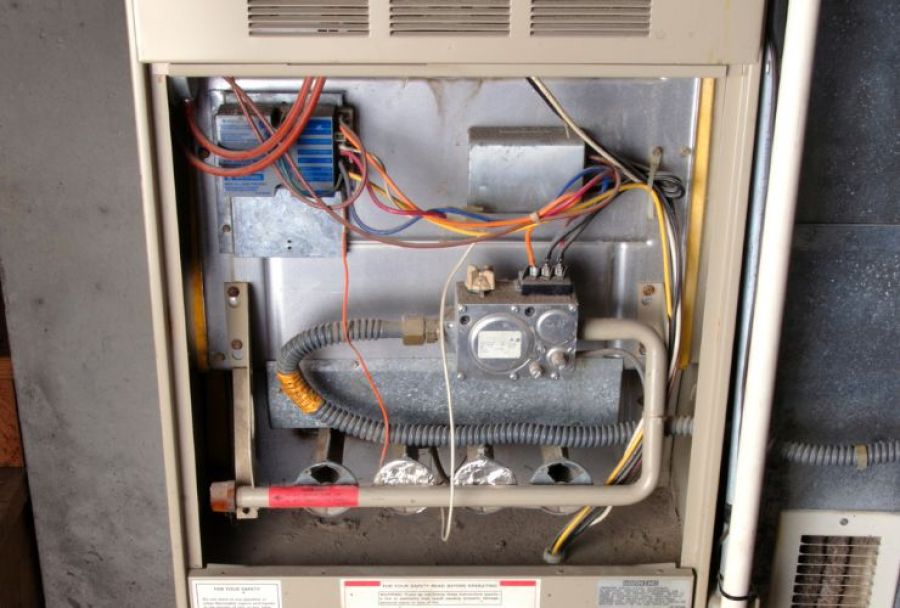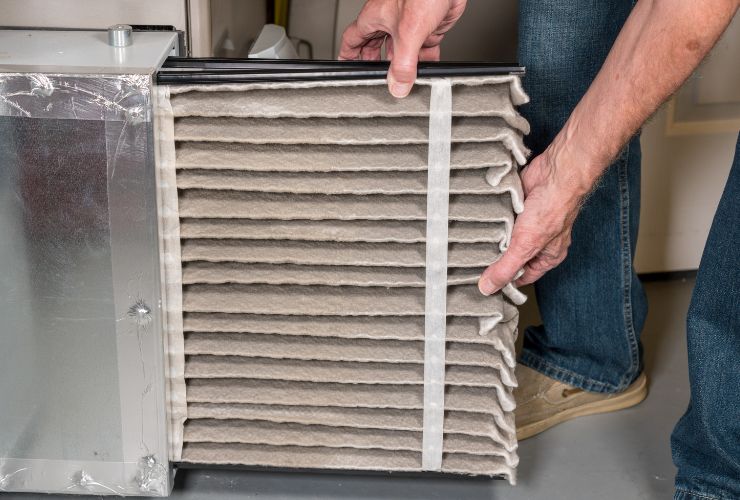Preparing Your Furnace for Winter: Essential Maintenance Tips

TLDR: Maintaining your furnace is crucial for a warm and comfortable home during winter. Regular maintenance improves efficiency, enhances safety, and extends the furnace’s lifespan. An efficient furnace reduces heating costs, ensures safety, and offers long-term value. The top 10 maintenance tips include replacing or cleaning air filters, inspecting and cleaning vents and ducts, testing the thermostat, lubricating moving parts, checking the blower motor, inspecting the ignition system, cleaning the heat exchanger, and testing safety controls. Professional servicing is recommended annually to catch potential issues early and ensure optimal performance.
As the winter months approach, ensuring your furnace is in top condition becomes essential to maintain a warm and comfortable home. Regular furnace maintenance not only enhances its efficiency but also extends its lifespan. In this blog, we’ll explore the importance of preparing your furnace for winter and provide you with essential maintenance tips to help keep your heating system running smoothly. Read on to discover how to stay cozy and worry-free during the cold season.
The Importance of Furnace Maintenance
Your furnace is an indispensable component of your home’s heating system, playing a vital role in ensuring your comfort and well-being, especially when the winter chill sets in. Neglecting the maintenance of this essential appliance can have far-reaching consequences, including reduced efficiency, higher energy bills, and the unfortunate possibility of a breakdown just when you need heat the most. Let’s delve deeper into why furnace maintenance should never be underestimated:
Furnace Efficiency
One of the primary reasons to prioritize furnace maintenance is its direct impact on efficiency. Your furnace’s efficiency is a measure of how effectively it can convert fuel or electricity into heat while minimizing waste. Over time, dust, debris, and wear and tear can compromise your furnace’s efficiency, causing it to work harder and consume more energy to provide the same level of warmth. When your furnace operates at its peak efficiency, it heats your home effectively while using less energy. This not only keeps you comfortable but also lowers your heating costs, which can be particularly noticeable during the cold winter months. By investing in regular furnace maintenance, you ensure that your heating system is operating as efficiently as possible, saving you money and reducing your environmental footprint.
Furnace Safety
Beyond efficiency, safety is a paramount concern when it comes to furnace maintenance. Your furnace produces heat through combustion (for gas or oil furnaces) or electrical heating elements, making it essential to ensure that this process occurs safely and without risks to your home or family. A well-maintained furnace is less likely to develop safety issues. For instance, routine inspections can detect potential problems, such as a cracked heat exchanger in a gas furnace, which can lead to carbon monoxide leaks. Carbon monoxide is a colorless, odorless gas that can be deadly when inhaled in high concentrations. Additionally, regular maintenance checks can identify and address overheating issues, faulty safety controls, or malfunctioning components that could otherwise pose serious health and safety risks to your family. By maintaining your furnace properly, you minimize the chances of dangerous incidents, ensuring your home remains a safe haven throughout the heating season.
Furnace Lifespan
Furnaces represent a significant investment in your home’s infrastructure, and it’s in your best interest to make that investment last. Furnaces that receive proper maintenance tend to have longer lifespans. Over time, the wear and tear on a furnace can take a toll on its components, potentially leading to breakdowns and the need for costly repairs or replacements. Regular servicing, on the other hand, can extend the life of your furnace, delaying the day when you’ll face the expense of a new unit. When you consider that a well-maintained furnace can continue to deliver reliable heating for many years, the cost savings and peace of mind that come with proper maintenance become evident. By scheduling regular maintenance, you not only protect your investment but also ensure that your furnace continues to provide dependable warmth, season after season.

Top 10 Essential Furnace Maintenance Tips
Your furnace plays a pivotal role in keeping your home warm and comfortable during the cold winter months. To ensure it operates efficiently and reliably, regular maintenance is key. In this guide, we present the top 10 essential furnace maintenance tips that will help you prepare your heating system for the winter season. From checking the air filter to testing safety controls, these tips will keep your furnace running smoothly and your home cozy.
Replace or Clean the Air Filter
A dirty or clogged air filter can significantly impact your furnace’s performance. It reduces airflow, forcing your furnace to work harder and potentially leading to damage. Make it a habit to inspect your air filter monthly and replace it when it’s dirty or follow the manufacturer’s recommendations. Proper filtration ensures optimal efficiency and indoor air quality.
Inspect and Clean Vents and Ducts
Ensuring unobstructed airflow is crucial for efficient heating. Check that vents and ducts are clear of obstacles, such as furniture or debris. Use a vacuum to remove dust and dirt around registers and inspect ductwork for leaks. Leaky ducts can result in heat loss, reducing the overall efficiency of your heating system.
Test the Thermostat
Your thermostat is the control center of your heating system. To ensure it’s working correctly, test it in both heating and cooling modes. Replace the batteries if necessary and consider upgrading to a programmable thermostat for improved energy savings and precise temperature control.
Lubricate Moving Parts
Furnace components with moving parts, such as motor and fan bearings, require proper lubrication to reduce friction and wear. Consult your furnace’s manual for guidance on lubrication intervals and the type of lubricant to use. Proper lubrication extends the life of these critical components.
Check the Blower Motor
The blower motor is a vital element of your furnace’s operation. It’s responsible for circulating heated air throughout your home. Regularly inspect it for dirt and debris, and clean it if necessary. Ensure that the blower belt is correctly tensioned, and replace it if it shows signs of wear. A well-maintained blower motor ensures efficient heat distribution.
Inspect the Ignition System
For gas furnaces, the ignition system is of paramount importance. A clean and functioning pilot light or flame sensor is essential for proper ignition. Regularly clean these components to ensure reliable performance. If you have an electronic ignition system, check for any issues with the control board and address them promptly to avoid ignition problems.
Inspect and Clean the Heat Exchanger
The heat exchanger is a critical furnace component responsible for transferring heat to the air that circulates through your home. Over time, it can develop cracks or corrosion, which can lead to carbon monoxide leaks—a potentially life-threatening issue. It’s highly advisable to schedule professional inspections for the heat exchanger, as repairing or replacing it requires specialized knowledge and tools.
Test Safety Controls
Safety controls, including limit switches and pressure switches, are in place to protect your furnace from overheating and other potential hazards. Ensure that these controls are functioning correctly by testing them periodically. Faulty safety controls can compromise your furnace’s safety and efficiency, so any issues should be addressed promptly.
Questions & Answers About Furnace Maintenance
How often should I schedule furnace maintenance?
It’s recommended to have your furnace professionally serviced annually before the start of the heating season. Regular maintenance can catch potential issues early and ensure optimal performance.
Can I perform furnace maintenance myself?
While some maintenance tasks, such as filter replacement and cleaning, can be done by homeowners, many aspects of furnace maintenance require professional expertise. Professional technicians have the training and tools to perform comprehensive inspections and repairs safely.
What are signs that my furnace needs professional attention?
If you notice any of the following signs, it’s time to call a professional technician:
- Unusual noises like banging or screeching.
- Inconsistent heating or frequent cycling.
- Uneven heating throughout your home.
- A sudden increase in energy bills.
- The presence of unusual odors, especially a sulfur or rotten egg smell, which could indicate a gas leak.
Conclusion
Preparing your furnace for winter through regular maintenance is a proactive step toward ensuring your home remains warm, efficient, and safe throughout the cold season. By following these essential maintenance tips and scheduling annual professional servicing, you can enjoy reliable and worry-free heating, lower energy costs, and peace of mind knowing that your furnace is ready to face the challenges of winter. Don’t wait until the chill sets in; take action now to keep your home cozy and comfortable during the winter months.
On standby waiting to help you with a FREE Quote right now!
Recent Posts
CATEGORIES





